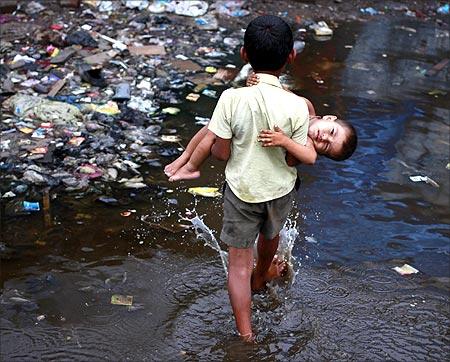
The Planning Commission said on Monday poverty in India declined 7.3 percentage points to 29.8 per cent of the population over five years to 2009-10.
Poverty in rural areas declined at a faster pace than in urban cities between 2004-05 and 2009-10, according to the Planning Commission estimates released on Monday.
The total number of poor in the country has been estimated at 34.47 crore in 2009-10, as against 40.72 crore (Rs 407.2 million) in 2004-05.
. . .
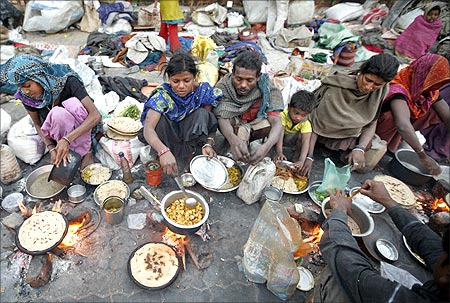
"The all India head count (HCR) ratio has declined by 7.3 percentage points from 37.2 per cent in 2004-05 to 29.8 per cent in 2009-10, with rural poverty declining by 8 percentage points from 41.8 per cent to 33.8 per cent and urban poverty declining by 4.8 percentage point form 25.7 per cent to 20.9 per cent," said an official statement.
The sharp decline in poverty of over 10 percentage points was witnessed in Himchal Pradesh, Madhya Pradesh, Maharashtra, Orissa, Sikkim, Tamil Nadu, Karnataka and Uttarakhand.
. . .
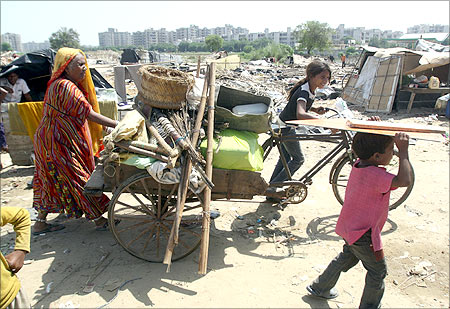
The data revealed that the poverty has increased in North-eastern states of Assam, Meghalaya, Manipur, Mizoram and Nagaland, the statement said.
Some of the bigger states, such as Bihar, Chhattisgarh and Uttar Pradesh have shown only marginal decline in poverty ratio, particularly in rural areas.
. . .

The Planning Commission's estimates of poverty are based on methodology recommended by the Tendulkar Committee, which includes spending on health and education, besides the calorie intake.
The data reveals that among religious groups, Sikhs have lowest poverty ratio in rural areas at 11.9 per cent, whereas in urban areas, Christians have the lowest proportion of poor in the country at 12.9 per cent.
In rural areas, poverty ratio for Muslims is very high in states such as Assam (53.6 per cent), Uttar Pradesh (44.4 per cent), West Bengal (34.4 per cent) and Gujarat (31.4 per cent).
. . .
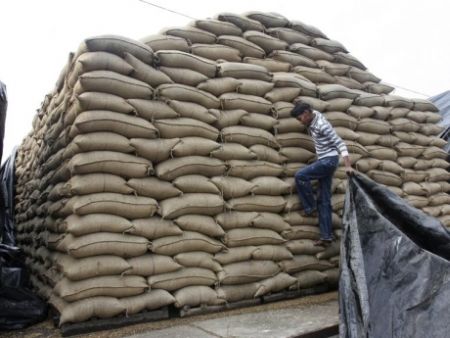
In urban areas, poverty ratio at all India level is the highest for Muslims at 33.9 per cent. Similarly, for urban areas, the ratio is high for Muslims in states such as Rajasthan (29.5 per cent), Uttar Pradesh (49.5 per cent), Gujarat (42.4 per cent), Bihar (56.5 per cent) and West Bengal (34.9 per cent).
Among social categories, Scheduled Tribes face the highest level of poverty at 47.4 per cent, followed by Scheduled Castes at 42.3 per cent and Other Backward Castes at 31.9 per cent as against 33.8 per cent for all classes in rural areas.
. . .

In urban areas, Scheduled Castes have poverty ratio of 34.1 per cent, followed by Scheduled Tribes (STs) at 30.4 per cent and Other Backward Castes at 24.3 per cent against 20.9 per cent for all classes.
In rural Bihar and Chhattisgarh, nearly two-third of SCs and STs are poor, whereas in states such as Manipur, Orissa and Uttar Pradesh the poverty ratio for these groups is more than half.
. . .

Among the states, high incidence of poverty ratio is witnessed in Bihar at (53.5 per cent) followed by Chhattisgarh (48.7 per cent), Manipur (47.1 per cent), Jharkhand (39.1) Assam (37.9 per cent) and Uttar Pradesh (37.7 per cent).
Among the various occupational groups, nearly 50 per cent of agricultural labourers and 40 per cent of other labourers are below the poverty line in rural areas, whereas in urban areas, the poverty ratio for casual labourers is 47.1 per cent.
Those in regular wage or salaried employment have the lowest proportion of poor.
. . .
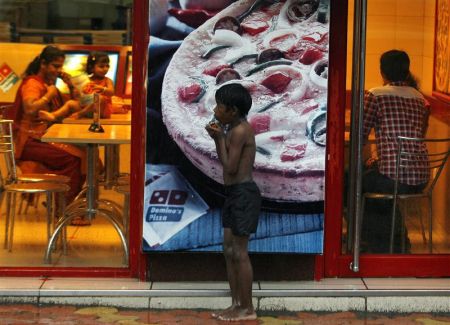
In the agriculturally prosperous state of Haryana, 55.9 per cent agricultural labourers are poor, whereas in Punjab the number is 35.6 per cent.
The poverty ration for casual labourers in urban areas is very high in Bihar (86 per cent), Assam (89 per cent), Orissa (58.8 per cent), Punjab (56.3 per cent, Uttar Pradesh (67.6 per cent) and West Bengal (53.7 per cent).
In rural areas, it is seen that households headed by minors have poverty ratio of 16.7 per cent and households headed by female and senior citizen have poverty ratio of 29.4 per cent and 30.3 per cent respectively.
. . .

In urban areas, households headed by minors have poverty ratio of 15.7 per cent and households headed by female and senior citizen have poverty ratio of 22.1 per cent and 20.0 per cent respectively against overall poverty ratio of 20.9 per cent.
In rural areas, the households with 'primary level and lower' education have the highest poverty ratio, whereas the reverse is true for households with 'secondary and higher' education.
Nearly two-third households with 'primary level and lower' education in rural areas of Bihar and Chhattisgarh are poor, whereas it is 46.8 per cent for Uttar Pradesh and 47.5 per cent for Orissa. The trend is similar in urban areas.